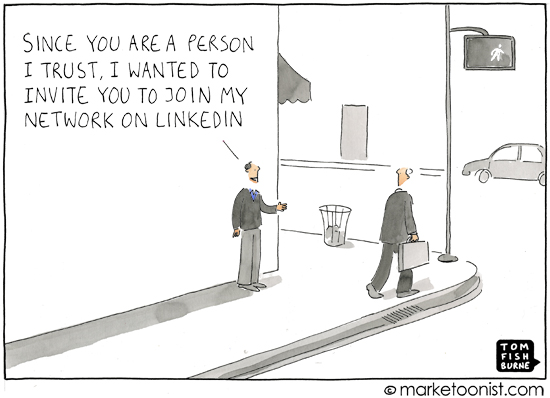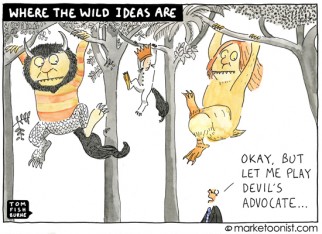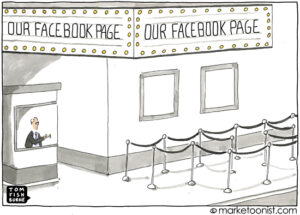I heard someone say recently that the difference between networking and not working is one letter.
I’m amazed how many LinkedIn requests are indiscriminately sent to acquaintances or strangers without even personalizing the generic invitation message: “Since you are person I trust…” Recently LinkedIn modified the generic message, but the same behavior is there. Many of these interactions start and end with that LinkedIn invitation. LinkedIn makes networking easier, but it can also make us lazy.
LinkedIn is a powerful tool. But it doesn’t replace networking. It enables it. We sometimes rely on LinkedIn as a crutch. Having a large network can give us a false sense of security. What’s far more important than the size of the network are the meaningful connections within the network.
Tom Peters wrote a classic Fast Company article in 1997 called “The Brand Called You” (which still feels timely aside from the blurb in Tom’s bio promoting his new “CD-ROM”). He writes:
“Regardless of age, regardless of position, regardless of the business we happen to be in, all of us need to understand the importance of branding. We are CEOs of our own companies: Me Inc. To be in business today, our most important job is to be head marketer for the brand called You.”
Marketing the brand called You does not mean asking as many people as possible to join our networks. Fewer meaningful interactions trump general, superficial ones.
(Marketoonist Monday: I’m giving away a signed print of this week’s cartoon. Just share an insightful comment to this week’s post. I’ll pick one comment by 5:00 PST on Monday. Thanks!)



Phil Gerbyshak says
Why does anyone send the default message? I mean really – who does that help, even if we know each other well? Nobody – except LinkedIn maybe.
Instead, why not try:
1- how we know each other. I mean really – tell me how we know each other.
2- how I can help you. I love to help people. Even complete strangers. Tell me how.
3- how you can help me. Maybe you love to help people and I look like I need help. Say so – and be specific. You won’t hurt my feelings. Honest.
Any of these are WAY better than the default. Lazy requests mean lazy networkers. Just say no!!!
Ann Stone says
Hey Tom – love this piece you posted today. I teach personal branding as the ending of my course on Branding at Western Washington University, and incorporate much of the same thinking although in a simpler fashion in my basic marketing courses. The idea of incorporating this thinking early in someone’s career is so critical – I came to it late, more or less finding Tom’s 1997 article to be the first true articulations of the concept.
When you market a brand you find followers and hang on to them and keep them happy. when you market a person you find followers and hang on to them and keep them happy. Its why a network should be looked at with the same metrics as brand awareness and advocacy.
Linked in is like any online technology – its a way to build your brand. If you’re doing it for a company, Linked In can assist you in finding the right followers and keep your current employees connected. For individual branding folks – branding all that makes them better, different and special – Linked In is a tool to provide exposure and brand reinforcement.
But Linked In, Facebook, Twitter and the like don’t build your brand – personal or otherwise.
thanks for the fun posting!
Earlene says
Many times I’ve received invitations and couldn’t even figure out what the connection was between me and the inviter. Phil’s suggestions certainly give more meaningfulness and power to an invitation. The ease of sending inviations to join your network has certainly reduced some of the thoughtfulness out of this type of “networking”.
Merete says
Tom, you are so spot on 🙂
Hilary says
Great cartoon Tom. You are succeeding in getting a reaction: making me think what is it really all about and how do people differ in their approach to using linked in.
The idea that trust has become so commoditised is scary.
Two other thoughts: the iphone app at least doesn’t allow you to add a message to a request so lack of time is stopping real messages getting through maybe. Also, I hear you can’t “unfriend” on linked in. Isn’t that an issue?
Jeff Brown says
Not only that, but I often experience ‘asks’ from folks I’ve only just connected with and otherwise didn’t know before. I heard Chris Brogan once say that’d be like “meeting someone for the first time in real life and, instead of shaking their hand, you stick your tongue in their mouth.”
Vicki S. Cannon says
Thank you! I express this same sentiment to the people I coach on Social Media. This is all about the connection – how impersonal is the “canned” message? Like you said, social media isn’t about replacing the personal connection, it’s about enhancing. How do I know you? Where have we met? Why I want to connect. These are the things that should be included in your message to connect on any site.
Bill Carlson says
Went one time to a colleague’s LinkedIn list of connections, found someone I wanted to reach out to, dropped my colleague a note asking if he could facilitate a connection. Colleague’s response was “oh, well, yeah, met him at some point, not sure he’ll remember me, but sure, feel free to mention my name.”
Hardly qualifies as a true connection, I think, at least if the point of LinkedIn is networking. As a “contact list in the cloud”, it’s a great way to keep up with… well… anyone who accepts invitations to link (I always accept!) but I’m skeptical of those with hundreds of names.
Think I’d be more impressed with folks who keep their connections down to those who they really know — people who would respond to an email or phone call. And keeping their list of connections public — sometimes we don’t know who we know know’s who we’d like to know… 😉
Tom McCool says
Isn’t networking about meeting people who you don’t know but might be a resource in the future? And also isn’t networking about connecting with not just one person, but with that person’s connections as well? Networking with people you already know isn’t networking.
Simon Rees says
Brilliant, as ever. 🙂
I blogged about your cartoon here http://www.idiro.com/blog/inherent-weakness-online-influence
Simon
Graham says
I recently requested LinkedIn recommendations from my closest connections absentmindedly using the default script. I got one reply from another user who was actively working on their profile.
My second try was to former colleagues, some of whom I haven’t been in touch with since initially connecting. This time I applied some basic personalisation:
– Reminder how and when we worked together
– What I am looking for in a recommendation
– Why I am asking for it now
Low and behold, the response rate was considerably higher. This approach is still too one sided and I think Phil Gerbyshak, suggestion is excellent. I will definately adopt this going forward.
Lesson learnt the hard way.
Susan says
LOL ‘toon, Tom!!!
… now “LOL” might have been a lazy & generic way to express my appreciation, but sometimes the truth needs few words (and I DID laugh outloud at it!)
If a connection is just someone I’ve met on Linked In the generic msg suffices (from or to them)… if it’s an old or new real-life contact, I’ll customize it.
Concetta Phillipps says
Brilliant as ever. I am irritated as all heck by those unpersonalized messages. I mean, if Macy’s can welcome me on their website, can’t people take the 30 seconds to write “Thanks for meeting with me yesterday at our POB*. Would you mind joining networks so we can stay in touch?”. *POB = Place of business.
LinkedIn folks should be nurtured over time, just like real networking contacts. Anyone over 100 contacts gets looked at with suspicion by me – can one really keep up with that many people well?
Julie Stofer says
LOVE this! I’ve just been talking about personal branding with the staff at my firm, and this really hits home for me. In fact, in my inbox this morning was yet another random request to connect (which I read as SPAM). I’m pretty liberal in who I’ll talk to if they find me on LinkedIn because they know someone who knows me and have a question or some sort of request. In that case, I’m more than happy to be a resource for them, because goodness knows I’ve had a lot of help along the way in my career, but I generally only accept connections from people I would be comfortable recommending, asking for an introduction from or making an introduction to. I also regularly “screen” my connections (as I do with Facebook), and if I can’t remember within a few seconds who someone is and how I know them, I disconnect from them.
Ruth Barnes says
Love this! And maybe it’s the third grader in me, but now I feel compelled to invite you to my network on linkedin. But I promise to write a personalized invitation that might even make you smile. 🙂
Jason Cross says
Another great exposure of laziness. Perhaps LinkedIn should not provide generic text, but instead force the ‘networker’ to add their own invitation – and not allow it to be sent blank?
Adding to the discussion already posted – I like LinkedIn for the ability to have a “contact list in the cloud” – but over time I am as guilty as many of forgetting the exact circumstances of some connections. An ability to add my own (private view only) notes to each contact so I can remember where/when/why we connected would be invaluable… perhaps with a primary and secondary contact segmentation tool (again, probably this should only be personally viewable, to spare the blushes and awkwardness for those deemed “secondary”) ?!
DSprogis says
Hey Tom,
I’m glad you addressed this. I think people are confused between social networking and asocial networking. I have grown tired of explaining to people that I won’t accept a link to people I don’t know, don’t trust and/or haven’t worked with.
Great post!
Dave
Rupert Graves says
I say.
Think before you click send. Hey, think before you even think about wanting to go onto LI an click send!
There are too many folks that ‘add’ for the wrong reasons. As a side note, I don’t want to be added to anything. I’m not an ingredient.
What’s you goal? Job interview? Getting back in touch? New business? etc
Can you achieve the same end goal by:
– tacking down the person (personal/company) tel number and calling them?? [old school. I know. But it worked wonders for Steve Job’s when he wanted parts from Mr Hewlett and Mr Packard!]
Only because it exists does not mean it is the best way to make an impression. And that’s waht we’re talkign about here. Making an impression.
Think.
Julie Stofer says
I second Jason’s idea about private notes.
Stephen Lahey says
Totally agree with your post, Tom. When sending an invitation – I like to give each person an explanation of how I know them (or, know of them) and actually give a reason why it would probably make sense to connect on LinkedIn. For example: “Hi Tom: I don’t know if you remember me, but we had a few phone conversations years ago when you were working for Gen Mills and Dreyers (I’m a CPG marketing recruiter). I own both of your books and I’ve enjoyed your blog for years now. I think that some of my clients might benefit from your services relating to challenger brand marketing and new product development. Let’s connect on LinkedIn and then chat directly, ok? – Stephen Lahey”
Allen Roberts says
Tom, I agree absolutely.
Usually when I get a generic message, I ignore it. However, from time to time I get one from someone I would like to be connected to, and in that circumstance, I ignore their generic request, and send one to them, personalised.
Tim Barkey says
Tom, as ever a nail struck squarely on the head . The first ever invite I had on linked had this exact lovely invite “a person I trust” – I was so flattered I accepted the invite immediately!
I tend to invite people i have met immediately so we can remember each other, make notes on where we met etc. and stay in contact as often as possible. I have also deleted people from contact lists which you can do on LinkedIn.
Like other posts above I do get messages randomly without any reason why…bizarre!
Trish says
Un-personalized LinkedIn requests are my No. 1 pet peeve. I often write back to ask how I know them and hear crickets. Also, it’s annoying when recruiters “link” to you… do they want you or access to your 500 contacts?
But at the end of the day, I really like LinkedIn to keep track of folks. I often only have work emails and if they leave that job I don’t have an email to reach out to them when something reminds me of them and I want to get in touch. With LinkedIn, I now do.
felicitee says
one day getting ready to present at a conference an old acquaintance mentioned that he was happy to have been approached by an associate of our company on linked in but didn’t know her.
I was able to respond with – I bet it was this woman in the row behind and introduce them face to face. Hilarious. But it worked well – they each knew so many of the same people they knew the connection was going to work.
Ahh bless Linked In
Thom I says
“Everything depends upon execution; having just a vision is no solution.” — Stephen Sondheim
Mariella D says
I might be wrong since I read it many years ago, but I think Tom Peters said in that same book that you are as important as your contact list. Which might give the false impression that quantity matters as much as quality…
Daniele says
Working and Networking – miss on networking and lose the other.
Loaded you cartoon on Pinterest, Tim; most are too good to be missed!
Cheers,
Daniele
Lexy says
Guilty – and I hesitated as I hit “send invite” too 🙁
tomfishburne says
Hi all,
Great commentary this week, thanks! It seems like a lot of us share this LinkedIn pet peeve. This week’s print goes to to Phil Gerbyshak for a succinct solution for helping us connect better on LinkedIn and elsewhere. Thanks!
-Tom
Lauren says
I just thought I’d let you know that this cartoon made me laugh for literally about five minutes straight, and then periodically during the day whenever I thought of it.
Good work. I enjoy your insights and drawings a great deal.
Rhonda says
I thought exactly like you, Tom, until I installed the LinkedIn app. It doesn’t give the option to modify the message. So it’s not just laziness, it’s a bad app design. So when I want to connect with someone I just wait till I’m in front of a PC.